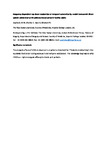Frequency-dependent top-down modulation of temporal summation by anodal transcranial direct-current stimulation of the primary motor cortex in healthy adults
| dc.contributor.author | Hughes, Sam | |
| dc.contributor.author | Ali, M | |
| dc.contributor.author | Sharma, P | |
| dc.contributor.author | Insan, N | |
| dc.contributor.author | Strutton, PH | |
| dc.date.accessioned | 2020-07-29T12:38:25Z | |
| dc.date.issued | 2018-09 | |
| dc.identifier.issn | 1090-3801 | |
| dc.identifier.issn | 1532-2149 | |
| dc.identifier.uri | http://hdl.handle.net/10026.1/16119 | |
| dc.description | 12 months embargo, now expired. | |
| dc.description.abstract |
Background Transcranial direct-current stimulation (tDCS) applied over the primary motor cortex has been shown to be effective in the treatment of a number of chronic pain conditions. However, there is a lack of understanding of the top-down analgesic mechanisms involved. Method In this study, we investigated the effects of tDCS on the facilitation of subjective sensory and pain scores using a transcutaneous electrically evoked measure of temporal summation. In this randomized, blinded, cross-over study healthy subjects received a single stimulus given at 0.9× pain threshold (pTh) over the L5 dermatome on the lateral aspect of the right leg, followed by a train of 5 stimuli given at 0.5, 1, 5 and 20 Hz before and after 20 min of sham or anodal tDCS (2 mA) applied over the primary motor cortex. Ratings of sensation and pain intensity were scored on a visual analogue scale (VAS). Results Temporal summation leading to pain only occurred at higher frequencies (5 and 20 Hz). Sham or real tDCS had no effect over temporal summation evoked at 5 Hz; however, there was a significant analgesic effect at 20 Hz. Sham or real tDCS had no effect over acute, single stimuli-evoked responses. Conclusion These results indicate that anodal tDCS applied to the primary motor cortex preferentially modulates temporal summation induced by high-frequency electrical stimulation-induced pain. The inhibitory effects of tDCS appear to be dynamic and dependent on the degree of spinal cord excitability and may explain the higher analgesic efficacy in patients with moderate to severe chronic pain symptoms. Significance The analgesic effects of tDCS are dependent on spinal cord excitability. This work provides insight into top-down modulation during acute pain and temporal summation. This knowledge may explain why tDCS has a higher analgesic efficacy in chronic pain patients. | |
| dc.format.extent | 1494-1501 | |
| dc.format.medium | Print-Electronic | |
| dc.language | en | |
| dc.language.iso | en | |
| dc.publisher | Wiley | |
| dc.subject | Chronic Pain | |
| dc.subject | Neurosciences | |
| dc.subject | Clinical Research | |
| dc.subject | Pain Research | |
| dc.subject | Neurological | |
| dc.title | Frequency-dependent top-down modulation of temporal summation by anodal transcranial direct-current stimulation of the primary motor cortex in healthy adults | |
| dc.type | journal-article | |
| dc.type | Journal Article | |
| plymouth.author-url | https://www.webofscience.com/api/gateway?GWVersion=2&SrcApp=PARTNER_APP&SrcAuth=LinksAMR&KeyUT=WOS:000441435800012&DestLinkType=FullRecord&DestApp=ALL_WOS&UsrCustomerID=11bb513d99f797142bcfeffcc58ea008 | |
| plymouth.issue | 8 | |
| plymouth.volume | 22 | |
| plymouth.publication-status | Published | |
| plymouth.journal | European Journal of Pain | |
| dc.identifier.doi | 10.1002/ejp.1238 | |
| plymouth.organisational-group | /Plymouth | |
| plymouth.organisational-group | /Plymouth/Faculty of Health | |
| plymouth.organisational-group | /Plymouth/Faculty of Health/School of Psychology | |
| plymouth.organisational-group | /Plymouth/REF 2021 Researchers by UoA | |
| plymouth.organisational-group | /Plymouth/REF 2021 Researchers by UoA/UoA04 Psychology, Psychiatry and Neuroscience | |
| plymouth.organisational-group | /Plymouth/REF 2021 Researchers by UoA/UoA04 Psychology, Psychiatry and Neuroscience/UoA04 Psychology, Psychiatry and Neuroscience MANUAL | |
| plymouth.organisational-group | /Plymouth/Users by role | |
| plymouth.organisational-group | /Plymouth/Users by role/Academics | |
| dc.publisher.place | England | |
| dcterms.dateAccepted | 2018-04-22 | |
| dc.rights.embargodate | 2020-8-1 | |
| dc.identifier.eissn | 1532-2149 | |
| dc.rights.embargoperiod | Not known | |
| rioxxterms.versionofrecord | 10.1002/ejp.1238 | |
| rioxxterms.licenseref.uri | http://www.rioxx.net/licenses/all-rights-reserved | |
| rioxxterms.licenseref.startdate | 2018-09 | |
| rioxxterms.type | Journal Article/Review |


